
|
Sale 39
Pre-Long Beach Coin and Currency Auction
| Lot |
Photo |
Description |
Realized |
Lot 2845 |
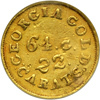 |
Christopher Bechtler, $2.50 GEORGIA, 64 gr. 22 carats. . Breen-7756, Kagin-11. NCS graded Sharpness of AU-50. Plugged. Much scarcer denomination and variety, the Bechtlers operated a mint in Georgia to strike gold coins from locally mined minerals for the better part of 20 years. This very rare variety has 2.50 [DOLLARS] on the obverse, 64G, 22 on the other, with the 22 uneven above CARATS. It is from the series VI period of Georgia Gold made under a 22 carats, 25.6 grains per dollar standard.
Estimated Value $4,000 - 4,500.
View details and enlarged photos
| Unsold |
Lot 2846 |
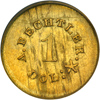 |
August Bechtler, 1 DOLLAR CAROLINA, 27 gr. 21 carats. PCGS graded MS-61. Well struck with light streaky obverse toning. Frosty surface. It is difficult for us to imagine that this piece could have survived so well preserved, with so few marks and such original uncleaned luster, when most of these are no better than EF. Pop 9; 14 finer (PCGS # 10040) .
Estimated Value $4,000 - 4,400.
View details and enlarged photos
Check results on similar lots
| Realized
$4,600 |
Lot 2847 |
 |
1849 Norris, Gregg & Norris (San Francisco) $5 Gold. Reeded edge. . Breen-7792, Kagin-3. PCGS graded VF-20. A smoothly worn Very Fine with excellent color, choice surfaces and rims, unusual quality in a slightly more worn Territorial, a coin that practically leaps out at you to bid. About the roughest surface area is at the center of the side with the 1849 date. Half eagles were struck by the firm Norris, Gregg and Norris in San Francisco (and some rare ones with the Stockton imprint as well). These were among the earliest California gold rush private gold pieces and usually did yeoman's duty in circulation before many were later melted for reminting into other private gold coins or (after 1854) into standard Federal double eagles and such. Variety with a reeded edge, no period after ALLOY. For further information on this early minter, numismatists are directed to the definitive work on the subject, the book Private Gold Coins and Patterns of the United States by Dr. Donald Kagin (PCGS # 10282) .
Estimated Value $5,000 - 6,000.
View details and enlarged photos
Check results on similar lots
| Realized
$5,463 |
Lot 2848 |
 |
1849 $5 Liberty. NCS graded Details of EF-40. Mount removed yet sharp enough to earn favorable mention. This piece may once have adorned a wife or ladyfriend of some early 49er miner, since it has the "sweated" appearance of having been worn as jewelry. All the same, it is an historic relic of America's (and California's) colorful past and should be pursued by all interested collectors.
Estimated Value $4,000 - 5,000.
View details and enlarged photos
| Realized
$4,140 |
Lot 2849 |
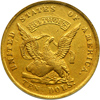 |
1852 Moffat & Co. (San Francisco) TEN DOLS. 2 over 1. . Breen-7711, Kagin-8. NCS graded Sharpness of AU-50. Improperly cleaned. A very pleasing looking example all the same. Some minor marks on reverse rim. Warm orange gold patina just having formed. Moffat & Company was one of the largest minting houses before the federal mint at San Francisco opened in 1854. The I in CALIFORNIA is repunched and the reverse always shows a diagonal break. All were struck February 11-14, 1852, with specimens from different ore deposits differing in color according to their alloy content.
In the early 1850s, the withdrawal of the discredited private coins of $5, $10 and $20 denominations as a result of the new U.S. Assay operations caused a new turn of affairs for Californians. Fractional currency coins of almost every nation were pressed into service by the Californians, but the supply was too small to help to any extent. Moffat & Company proceeded in January 1852 to issue a new ten-dollar gold piece bearing a Liberty head and also one with this eagle and shield motif.
Estimated Value $5,000 - 5,500.
View details and enlarged photos
| Unsold |
Lot 2850 |
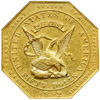 |
1852 U.S. Assay Office $50 Gold, 900 THOUS. NGC graded AU-53. Untoned and well struck. Small mark by the eagle's foot. The San Francisco Mint did not issue coins until 1854, but the West Coast economy, then in the midst of a boom, required growing supplies of gold coinage as early as 1849, the beginning of the gold rush. In 1851, the U.S. Assay Office in California became for want of a better term, the semi-official U.S. mint, under the charge of U.S. Assayer Augustus Humbert, who operated using the facilities of Moffat & Company, another early Territorial gold issuer. While Assay Office Fifties are not rarities, by the standards of Territorial gold, most are poorly preserved. They were used in circulation, where they received edge bumps, digs, and massive wear. Many were later melted, to be minted into Federal double eagles after 1854. Among the small number of choice About Uncirculated survivors this handsome piece shows few of the usual abrasions; it is not only choice, it is lustrous, and not only is the strike full and intricate, but of chief importance, the eye appeal is exceptional for the type. Pop 6; 21 finer.
Estimated Value $25,000 - 27,000.
View details and enlarged photos
| Unsold |
Lot 2851 |
 |
1853 U.S. Assay Office $20 Gold, 900 THOUS. NGC graded MS-60. Scattered marks and some bumps around the borders. A satiny gold specimen with faint golden zephyr-like wisps of iridescence on both sides. Nicely struck for the date, certainly much finer in the centers than most Territorial issues. The rims are somewhat problem-plagued, and there are a fair number of slight abrasions from circulation, but the extremely bold relief on the eagle with its arrows and shield are what first catches attention. Worthy of strong bidder participation (PCGS # 10013) .
Estimated Value $8,000 - 9,000.
View details and enlarged photos
Check results on similar lots
| Unsold |
Lot 2852 |
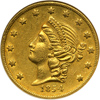 |
1854 Kellogg & Co. (San Francisco) $20 Gold. NGC graded AU-58. Boldly struck in rich golden-orange color gold and some light marks on the portrait plus nearby in the field. Smooth warm golden color offers the inspector of this handsome coin plentiful luster, sharp bold relief on the main devices, and the pleasure of noting full, complete, unbroken (undamaged) rims. Just the ticket for someone looking for a well made Kellogg and Company twenty-dollar gold Territorial from the California Gold Rush era (PCGS # 10222) .
Estimated Value $10,000 - 12,000.
View details and enlarged photos
Check results on similar lots
| Unsold |
Lot 2853 |
 |
1854 Kellogg & Co. (San Francisco) $20 Gold. PCGS graded AU-53. A nice sharp strike with the usual assortment of light contact marks. Struck in natural greenish color gold. Unrivaled in terms of exterior presentation, both sides of this golden beauty are well frosted and for all intents and purposes tone-free. So much, then, for the surface originality. As for the devices themselves, these were struck with sufficient power by the Territorial dies that they left all design elements showing, and showing clearly, unlike many early California pieces where a few areas mushy. If you are looking to buy just one historic gold coin from this era in our history, the present Kellogg & Company $20 gold piece should prove an ideal selection. Pop 13; 30 finer (PCGS # 10222) .
John Glover Kellogg and G. F. Richter were, respectively, cashier and assayer of Moffat & Co., before and during the subcontract linking that firm with Augustus Humbert's U.S. Assay Office (the Provisional Branch Mint). On the same day that the latter dissolved, Dec. 14, 1853, Kellogg and Richter opened their own assaying establishment in response to urgent requests from local bankers. The pair had struck $20 gold pieces in 1854 and 1855.
Many high-grade survivors dated 1854 come from the Thayer County hoard. This consisted of 58 pieces found by two boys in the woods near Alexandria, Nebraska in 1907. Supposedly two ranchers, Bennett and Abernathy, hid them there in 1867, while vainly trying to escape hostile Indians. Plans by Kellogg & Company to issue a $50 coin went as far as striking about 12 Proof samples.
Estimated Value $6,500 - 7,500.
View details and enlarged photos
Check results on similar lots
| Realized
$7,475 |
Lot 2854 |
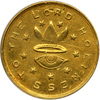 |
1850 Mormon $5 Gold. PCGS graded AU-58. PCGS holder 7996479. Nice mint luster with lightly golden toning. Full struck with full fingers showing. A few minor obverse nicks above LORD and to the right of the crown. Well struck and a fully mint state coin down graded slightly for the minor nicks. One of the finest examples we have ever handled. This coin has been in the same family for over 100 years and never auctioned before. Housed in PCGS holder 07996479.
The Mormon gold coins, struck on the orders of Brigham Young, were often of superior quality despite the poor equipment on hand to produce them. The coins were all struck in 1849 and 1850 using a uniform system of determining weight and fineness; none were issued with the 1851 date. Due to the softness of pure gold a small percentage of silver was added to create an alloy, and thus, were more durable in circulation.
The Mormon gold coins were struck mainly so the people within the settlement would have a sound means of exchange to purchase goods produced back East, in the industrial part of the country. However, some were also traded to the few non-Mormon businesses located in Utah. Because most of the coins were shipped East, there were virtually none left in circulation in the Mormon local market, according to historical records (PCGS # 10265) .
The devices chosen on this piece are significant to the Mormon Church. On the obverse, the Emblem of the Mormon Priesthood was placed, a three pointed Phrygian crown above the all-seeing eye. HOLINESS TO THE LORD surrounds these central devices. On the reverse, the clasped hands symbolize friendship, G.S.L.C.P.G. is abbreviated for Great Salt Lake City Pure Gold despite the gold having come from California.
Estimated Value $50,000 - 55,000.
View details and enlarged photos
Check results on similar lots
| Realized
$57,500 |
Lot 2855 |
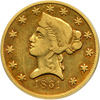 |
1861 Clark, Gruber & Co. (Denver, Colorado) $10 Gold. PCGS graded VF-25. Lightly toned, the fields display warm orange-gold color while the smooth surface of the worn high points contrasts with lighter typical golden color. Choice fields and surfaces abound (a wonderful exception to the usual abraded condition of these) and bidders may want to make a notation in their catalogs. The firm of Clark, Gruber & Co., Leavenworth, Kansas bankers, established a branch in Denver following discovery of gold deposits in the area in the mountains to the west. From that start would develop Colorado's largest mint, an operation which later became the foundation for the U.S. Denver Mint. Partners were Austin M. Clark, Milton Edward Clark, and Emanuel Henry Gruber and their $10 gold pieces were issued in 1860 and 1861 (PCGS # 10141) .
Estimated Value $3,000 - 3,300.
View details and enlarged photos
Check results on similar lots
| Realized
$3,680 |
|
|